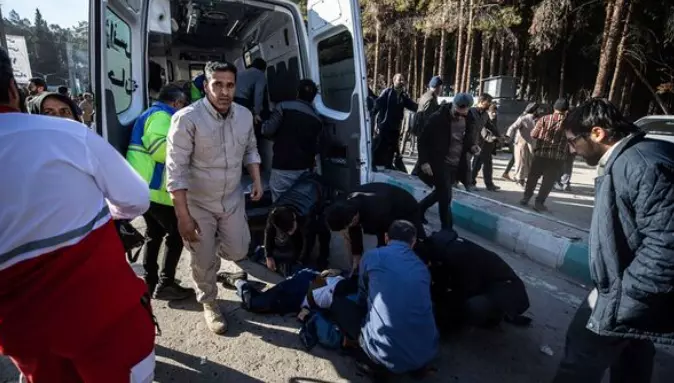
Death toll in twin blasts near Iran commander Soleimani's grave revised down to 95
While no one immediately claimed responsible for the attacks, Iran’s leaders have vowed that the attackers will be identified and punished

Iranian authorities have revised the death toll in the twin explosions on Wednesday (January 3) a commemoration ceremony for a prominent Iranian general slain by the US in a 2020 drone strike, to 95 from the earlier 103.
The massacre happened at a memorial service marking the fourth anniversary of the killing of Qassem Soleimani, the chief of Iran’s al-Quds force.
While no one immediately claimed responsibility for what appeared to be the deadliest militant attack to target Iran since its 1979 Islamic Revolution, newspapers in Iran suspected it to be a handiwork of either Israel or the Islamic State.
Iran's leaders vowed to punish those responsible for the blasts, which wounded at least 211 people.
While the death toll was revised down, Iran’s Health Minister Bahram Einollahi said it may rise as several wounded are in a critical condition.
The blasts were minutes apart and shook the city of Kerman, about 820 km (510 miles) southeast of the capital, Tehran. The second blast sprayed shrapnel into a screaming crowd fleeing the first explosion.
An earlier death toll of 103 was revised lower after officials realised that some names had been repeated on a list of victims, Einollahi, told state television.
Twin explosions, more fatalities
The explosions occurred near Soleimani’s grave site as long lines of people gathered for the event. Iranian state television and officials described the attacks as bombings, without immediately giving clear details of what happened. The attacks came a day after a deputy head of the Palestinian militant group Hamas was killed in a suspected Israeli strike in Beirut.
The first bomb on Wednesday was detonated around 3 pm, and the other went off some 20 minutes later, the Iranian interior minister, Ahmad Vahidi, told state television. He said the second blast killed and wounded the most people.
Images and video shared on social media appeared to correspond with the accounts of officials, who said the first blast happened about 700 metres (765 yards) from Soleimani's grave in the Kerman Martyrs Cemetery near a parking lot. The crowd then rushed west along Shohada Street, where the second blast struck about 1 km (0.62 miles) from the grave.
A delayed second explosion is often used by militants to inflict more casualties by targeting emergency personnel responding to an attack. Iranian state television and state-run IRNA news agency quoted emergency officials for the casualty figures.
Supreme leader vows ‘harsh response’ for attackers
Authorities said Thursday would be a national day of mourning. Iran's Supreme Leader Ayatollah Ali Khamenei said the attackers will face "a harsh response", though he did not name any possible suspect.
Iranian President Ebrahim Raisi added: "Undoubtedly, the perpetrators and leaders of this cowardly act will soon be identified and punished." Iran has multiple foes who could be behind the assault, including exile groups, militant organisations and state actors.
While Israel has carried out attacks in Iran over its nuclear programme, it has conducted targeted assassinations, not mass casualty bombings. A US State Department spokesman, Matthew Miller, said American officials had "no reason" to believe Israel was involved in Wednesday's attack in Iran.
Sunni extremist groups, including the IS group, have conducted large-scale attacks in the past that killed civilians in Shiite-majority Iran, though not in relatively peaceful Kerman. Iran also has seen mass protests in recent years, including those over the death of 22-year-old Mahsa Amini in 2022. The country also has been targeted by exile groups in attacks dating back to the turmoil surrounding its 1979 Islamic Revolution.
Iran’s brush with terrorism
Iran itself has been arming militant groups over the decades, including Hamas, the Lebanese Shiite militia Hezbollah and Yemen's Houthi rebels. As Israel wages its devastating war in Gaza after Hamas' October 7 attacks that killed 1,200 people, both Hezbollah and the Houthis have launched attacks targeting Israel that they say come on behalf of the Palestinians.
Israel is suspected of launching the attack on Tuesday that killed a deputy head of Hamas in Beirut, but that attack caused limited casualties in a densely-populated neighbourhood of the Lebanese capital. Last week, a suspected Israeli strike killed a Revolutionary Guard commander in Syria.
A Houthi spokesman, Mohammed Abdel-Salam, sought to link the bombings to Iran's "support for the resistance forces in Palestine and Lebanon", though he did not specifically blame anyone for the attack.
In Beirut, Hezbollah leader Hassan Nasrallah called the people who died in the attacks "martyrs who died on the same road, cause and battle that was led by" Soleimani.
The government of neighbouring Iraq expressed condolences to the victims, and the European Union issued a statement offering its "solidarity with the Iranian people".
Who was Soleimani?
Soleimani was the architect of Iran's regional military activities and is hailed as a national icon among supporters of Iran's theocracy. He also helped secure Syrian President Bashar Assad's government after the 2011 Arab Spring protests against him turned into a civil, and later a regional, war that still rages today.
Soleimani had been relatively unknown in Iran until the 2003 US invasion of Iraq. His popularity and mystique grew after American officials called for his killing over his help in arming militants with penetrating roadside bombs that killed and maimed US troops.
A decade and a half later, Soleimani had become Iran's most recognisable battlefield commander. He ignored calls to enter politics but grew as powerful, if not more so, than its civilian leadership.
(With inputs from agencies)

